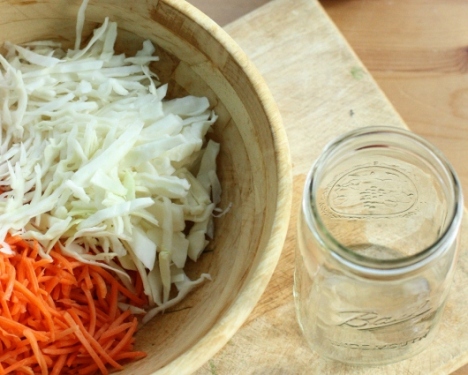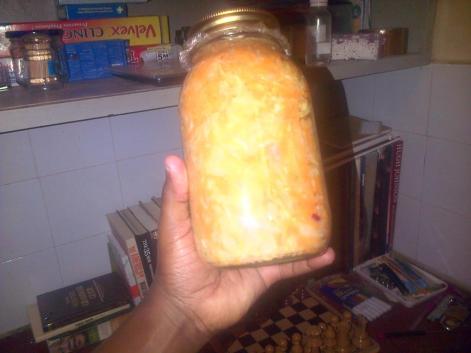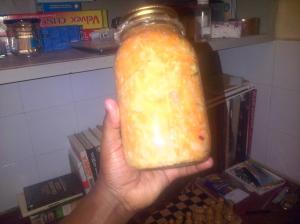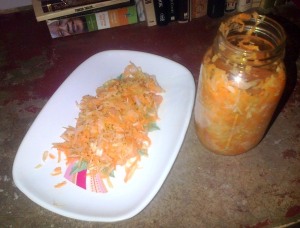Making fermented vegetables in your kitchen is so easy, I’ve done it a couple of times now and it only takes me a few minutes, I am going to show you how simple it is. By now am sure you are aware of the healthful benefits of having this fantastic dish as a part of your meal.
Generally, fermentation has traditionally been used by cultures all over the world as a means of preserving food, in our case vegetables. In addition to preserving the vegetables, it enhances their nutritional value, makes them more digestible and extremely nutritious 🙂 It also populates them with living bacteria that goes on to live in our digestive system enabling us to effectively digest all the other food that we eat.
It really is easy to make. Essential it simply is chopping up the veggies, adding a little bit of salt, stuffing them in a jar and waiting. I assure you, once you make your own, you will never look back.
Fermenting veggies requires no special equipment or expertise. So let’s gather the ingredients and make some…
Essentially what you need are some vegetables (cabbage, carrots, some garlic, onions and salt)
Materials
- a cutting board for chopping the vegetables
- Knife for shredding your veggies
- if you like you can use a grater
- a big bowl for mixing up your veggies after chopping them
- a source for your fermentation i.e a jar that you find in your kitchen (mason jar works well)
Ingredients
- 1/2 cabbage head
- 4 carrots
- 1 onion
- a clove of garlic
- sea salt (do not use iodized salt)
Here we go, let us get started…
The first thing we need to do is chop the washed cabbage, onions, garlic and grate the carrots. This increases the vegetables surfaces area.
With the vegetables on the bowl, lightly sprinkle salt on them. The key is to sprinkle the salt lightly, because at the end we will mix it all together and taste it.
I like to use colored vegetables like beets and carrots because it makes the fermented vegetables more appeasing to the eye and of-course the colors bring different nutrients in the food, so don’t be afraid to use colored veggies.
Then mix the vegetables. As you mix them, squeeze them too. What squeezing does is it breaks the vegetables’ cell wall. The cells hold their juices in but we want them to release their juices, so that the vegetables can be submerged in them. Mix the vegetables and squeeze them and as you do this for a couple of minutes, you will notice that they start to get wet 🙂
Once the juices have come out of the vegetables, it’s time to pack them into a vessel. Probably the easiest vessel you will have at home is a glass jar but a ceramic pot works perfectly well. Material to avoid is metal because the salt and lactic acid will corrode it. Also do not use plastic because the chemicals in the plastics will leach out of them and into the fermented veggies over time.
With your hand pack the vegetables tightly into the jar. What we need to ensure is that the brine submerges the vegetables.
Things to remember
Check periodically to make sure the fermented vegetables remain under brine- add water if necessary. It is very important to ensure the veggies remain submerged in brine.
If you are sealing the vegetables in a jar, be sure to release the pressure that will eventually build up. If you are using a ceramic pot, place a plate on top of the vegetables and a jug of water or other weight on top of the plate to keep the vegetables submerged. Drape a cloth over the top to keep flies away.
If surface mold develops, which is a very common problem, scrap them away. Remove any discolored vegetables, the vegetables underneath are still fine to eat.
Fermented vegetables are intrinsically safe because the acidic environments are inhospitable to food poisoning micro organisms.
How long to ferment your veggies?
How I do it is I taste the vegetables regularly. I try them after a few days and then again after a few more days. I finally found that on the fourth day they taste good. The cooler a place is the more time it takes to ferment them and a hot humid area takes much shorter to ferment. so taste them regularly after a few days and you will get how long you should ferment your vegetables.
I hope you are inspired to try and make your very own fermented vegetables and become a part of the fermentation revolution.
References
- The Art of Fermentation: An In-Depth Exploration of Essential Concepts and Processes from Around the World by Sandor Ellix Katz
- Wild Fermentation: The Flavor, Nutrition and Craft of Live Culture Foods by Sandor Ellix Katz






